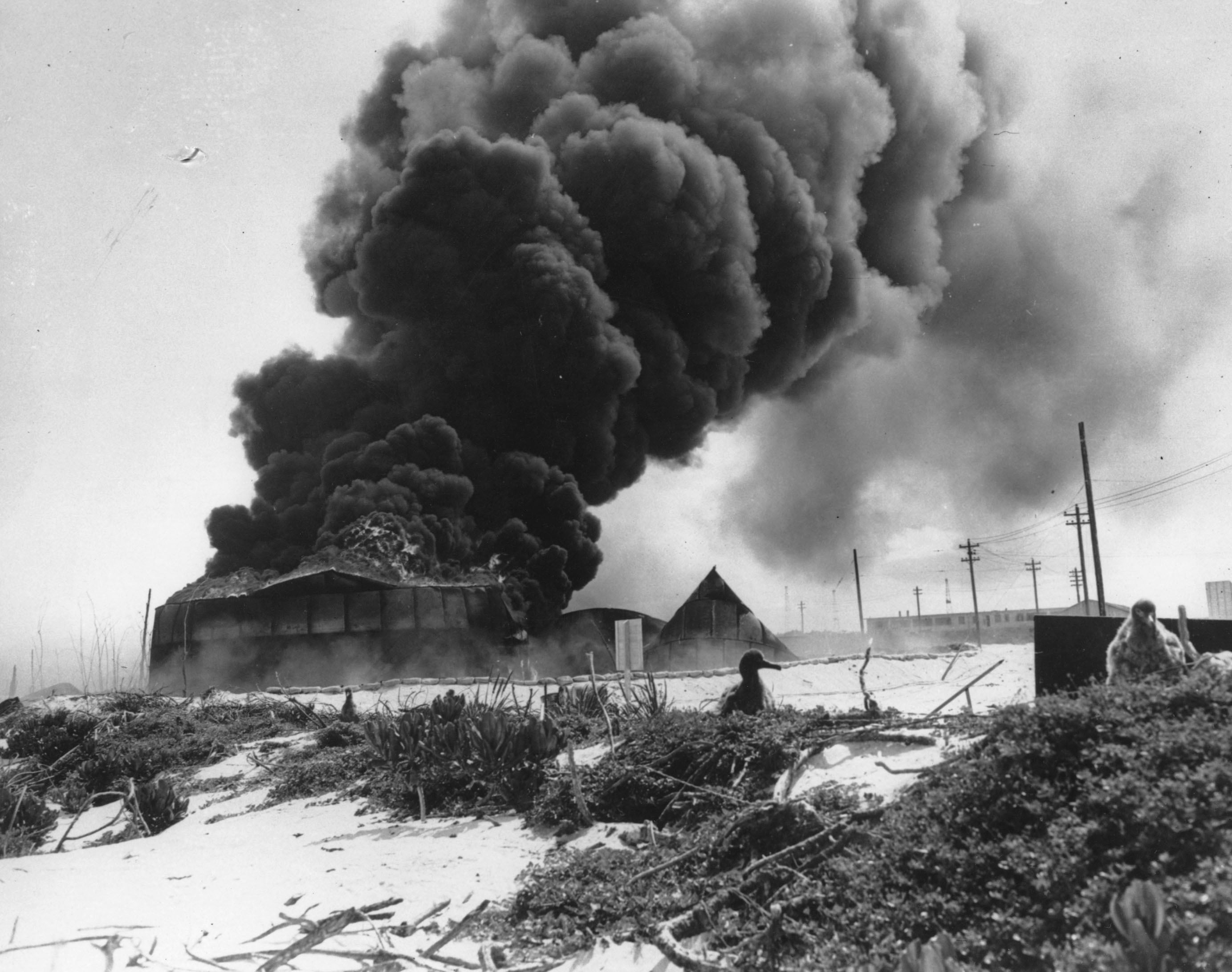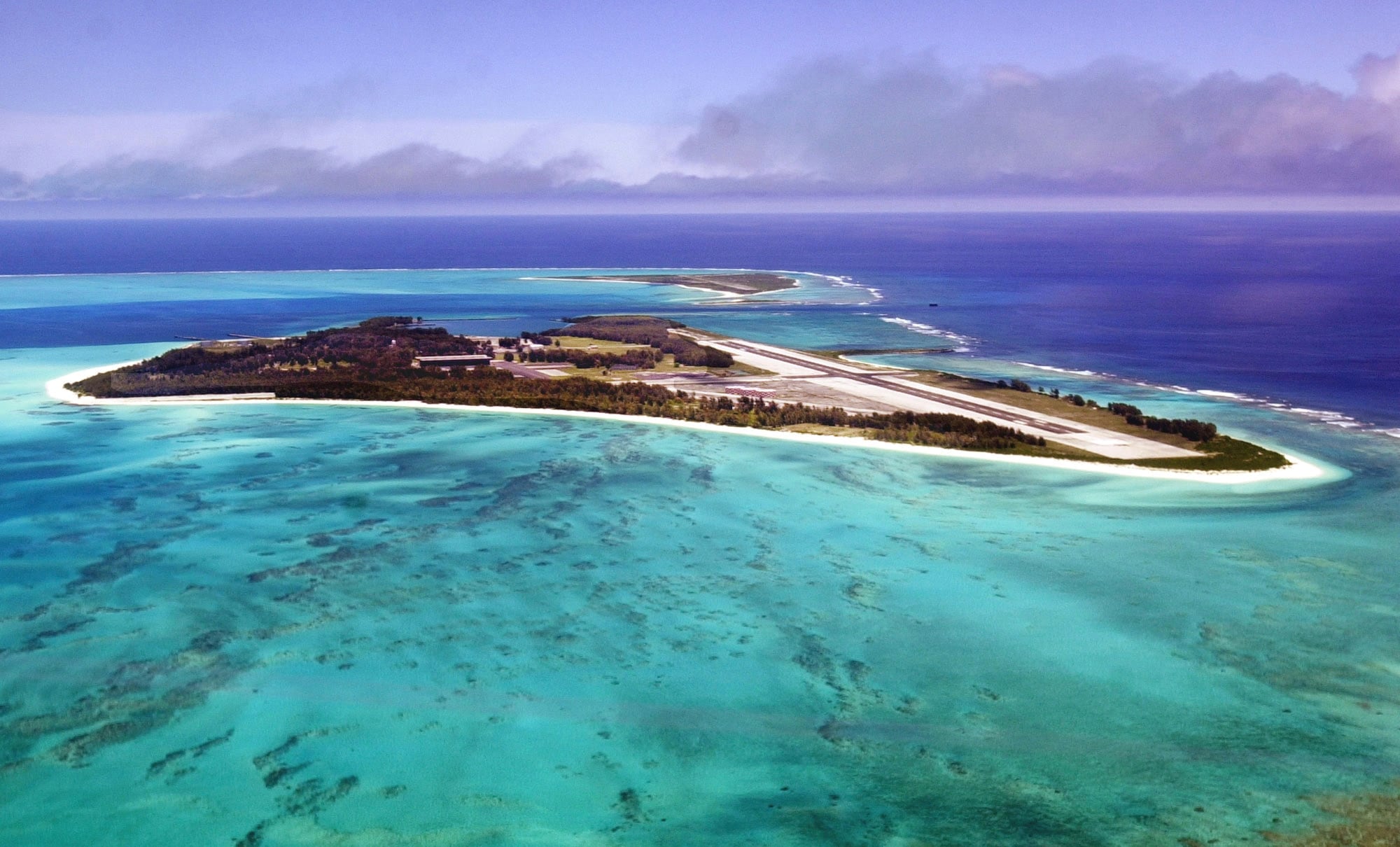
President Barack Obama pauses at the Battle of Midway Navy Memorial as he tours Midway Atoll on Sept. 1, 2016, in the Papahanaumokuakea Marine National Monument, Northwestern Hawaiian Islands.
Photo Credit: Carolyn Kaster/AP
The atoll is a place where many people have lived, and perished — almost 3,000 in the historic conflict with Japan. And the public hasn't been allowed to visit the refuge or the battle monuments for years.
Midway, about 1,200 miles north of Honolulu, is now a mix of boarded-up buildings left over from the island's military heyday and freshly painted facilities still in use by the U.S. Fish and Wildlife Service.
About 50 agency staff and volunteers live on the atoll at any given time, staying in renovated military housing.
During its military prime, up to 5,000 people were stationed on Midway. A public visitation program in the late 1990s allowed 100 people per week, plus support staff, to stay on the island.
Today, only volunteers, researchers and journalists can request a permit to visit the remote atoll. Approval can take up to a year and isn't guaranteed. Exceptions are made, such as for the battle's upcoming 75th anniversary, when about 25 people will attend a ceremony.
"Fish and Wildlife has every right and obligation to protect the wildlife, but they also have an obligation to protect the historic sites and the meaning of Midway," said James D'Angelo, founder of the International Midway Memorial Foundation. "It is precisely because of the men that lived and died that that memory should never be forgotten."
Six months after the Pearl Harbor attack, American forces turned away the Japanese at Midway and went on the offensive. In all, 2,500 Japanese and 307 Americans were killed in the battle.

In this June 1942 file photo, black smoke rises from a burning U.S. oil tank, set afire during the Battle of Midway on Midway Atoll.
Photo Credit: Cliff Owen/AP
The Midway Atoll National Wildlife Refuge was established in 1988 when the atoll was still under Navy control. In 1996, management was transferred to the wildlife agency with a mandate to maintain and preserve not only the wildlife but the atoll's historical significance.
Since 2000, the site has been designated as a National Memorial to the Battle of Midway. The original seaplane hangar is rusted and has shrapnel pockmarks. Behind it, a huge pile of desks, bicycles and broken speedboat engines await removal.
Midway sits amid a collection of man-made debris called the Great Pacific Garbage Patch. Along Midway's paths are piles of feathers with rings of plastic in the middle — remnants of birds that died with the plastic in their guts. Each year the agency removes about 20 tons of plastic and debris that washes ashore.
The critically endangered short-tailed albatross can be found only on Midway and one other small Pacific island. Endangered Hawaiian monk seals and green sea turtles also frequent Midway's shores.
In 1996, the government reached an agreement with the Georgia-based Phoenix Midway Corp. to help operate the island's visitor program, with lodging, a restaurant, a dive shop and bowling alley, at no cost to taxpayers.
But, in its six years of operation, the company had only one profitable month, according to a document submitted to Fish and Wildlife and provided to The Associated Press by the memorial foundation.
In mid-2001, the company pulled out. After that, there was either no visitor program or a limited one.
"It's financial suicide for anybody to think that they can go in unless they were given the carte blanche rights to run the island," said Bob Tracey, Phoenix Midway's former executive vice president.

Waves crash on the shores of Midway Atoll in the Northwestern Hawaiian Islands on June 5, 2002. The Battle of Midway was a major turning point in World War II's Pacific theater. But the remote atoll where thousands died is now a delicate sanctuary for millions of seabirds, and a new battle is pitting preservation of its vaunted military history against the protection of its wildlife.
Photo Credit: Ronen Zilberman/AP
In 2014, the Congressional Subcommittee on Fisheries, Wildlife, Oceans and Insular Affairs held an oversight hearing about Midway. "Objective observers can certainly question whether it was a mistake to transfer this sacred ground to an agency that is far better equipped to maintain birds than visitors," said the chairman, Rep. John Fleming, R-La.
The Government Accountability Office concluded in 2016 that the wildlife agency maintained most historic properties but tore down seven others without the required public notice.
But the GAO noted funding has been slashed from $4 million annually to less than $3 million, resulting in the end of public visitation in 2012.
Officials say more than $1 million a year would be required to reestablish a visitation program, excluding startup costs.
Matthew Brown, Fish and Wildlife's superintendent for the marine national monument, said sustainable tourism is feasible despite the challenges. "It's a very logistically challenging place to do anything," he said.
Its World War II-era structures weren't built to last, and some are coated in lead paint, Fish and Wildlife spokeswoman Megan Nagel said, noting Laysan albatross ingest the paint chips, causing illness.
Too many visitors could disturb the delicate ecosystem, Nagel said.
Some contend a private company could easily profit from a Midway visitation program, but "evidence shows that is historical fiction," Guam Rep. Madeleine Bordallo said at the 2014 congressional hearing. "Preservation of historic resources is expensive. If we value it as a country, we should pay for it."
Correspondent Caleb Jones reported from Honolulu.








